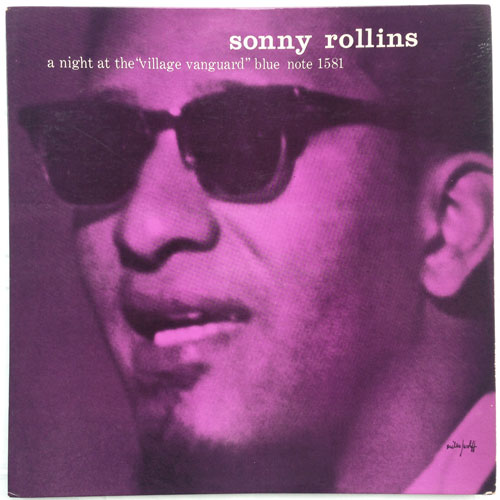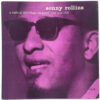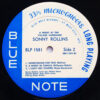- Original 1957 pressing (mono)
- West 63rd address on both labels without registered trademark “R”
- Deep groove on both sides
- Plastylite “P” etched and “RVG” stamped in dead wax
Personnel:
All but “A Night in Tunisia”:
- Sonny Rollins, tenor saxophone
- Wilbur Ware, bass
- Elvin Jones, drums
“A Night in Tunisia” only:
- Sonny Rollins, tenor saxophone
- Donald Bailey, bass
- Pete La Roca, drums
Recorded live at The Village Vanguard, New York City, November 3, 1957
Originally released December 1957
Selections:
“Old Devil Moon”
“Softly As in a Morning Sunrise”
For Collectors
If anybody reading this follows Al Perlman at JazzCollector.com, you are probably familiar with a recent acquisition of his from a late Baltimore collector named Bruce West. I met Al for the first time at the 2013 WFMU Record Fair in New York City this past November, and I am proud to say that this copy of A Night at the Village Vanguard is from that collection. Al explained that each record had a small date neatly written on the back of the jacket assumed to be the date the record was purchased — pretty cool, huh? Well the date on this one is “2-27-58”, and if we take into account the identifiers I have listed above, what we have here is no doubt an original pressing!
For Music Lovers
Thelonious Monk once said that he thought of his studio albums as advertisements for his live performances. John Coltrane expressed a similar sentiment during a radio interview in Japan when he said, “Some of (my best music) hasn’t been recorded. Recordings always make you, just a little bit, tighten up.” Though we all know that the recording sessions responsible for our favorite classic jazz albums captured phenomenal studio performances, it makes sense to me that a live performance might — according to the artist — guarantee a slightly greater degree of authenticity.
Perhaps Monk and Trane are offering some insight into why an album like A Night at the Village Vanguard sounds so real and so raw. Rollins was a music rebel: I like to think of him as the most “punk rock” of all the bop greats (he even sported a mohawk over a decade before the inception of punk). He was also an insatiable innovator, so much that he went on a three-year hiatus from public and studio appearances because he was dissatisfied with his own progress as an artist. By 1957, it was apparent that Rollins felt confined to the underlying harmonic structure naturally imposed on him by piano accompaniment. His solution as a leader? Get rid of the piano player. Rollins recorded his first entire LP without keys in March of that year (Way Out West, Contemporary 3530), and on this November Vanguard date he decided to expand on the idea with two different rhythm duos during the afternoon and evening sets, respectively.
I chose “Softly As in a Morning Sunrise” here not only for the refreshingly humble solos from all three members of the evening trio (Rollins, Wilbur Ware, and Elvin Jones), but also for its sonic brilliance. I love how immediate and direct Rollins’ horn sounds (partly due to the lack of piano), and things are quiet enough during the bass and drum solos (audience included) for us to hear each and every nuance. I’ve always had a thing for drums, and Jones’ kit is astonishingly tight, tuned, and clear here — especially the bass drum. The only shortcoming is that the overhead miking of the drums tends to overload from time to time, resulting in the occasional distorted cymbal crash. I was originally going to make this track my only selection, but I didn’t think it was representative of the overall upbeat mood of the album. So I decided to also include the opener, “Old Devil Moon”, a catchy reworking of the classic Broadway showtune.
The complete survived takes from this session were first issued in 1999 on double-CD. Numbering triple the amount of songs here, this can be a daunting listen. I was first exposed to A Night at the Village Vanguard through the reissue, and as a record collector who has always approached music with a “less is more” mentality, I just focused on the original track listing anyway — which in all likelihood was carefully curated by Blue Note founder Alfred Lion. Someday I will probably get to a point where I feel familiar enough with this LP to move on to the rest of the reissue. But until then, I like that the record’s concise program naturally encourages me to focus more on the details of a smaller amount of material.





